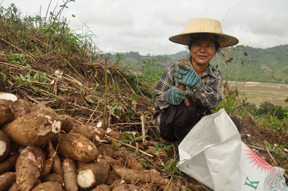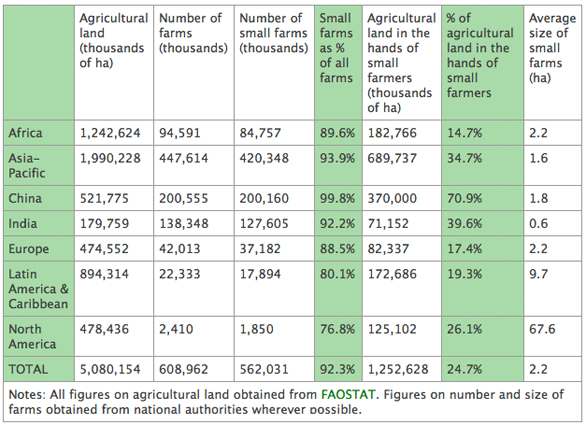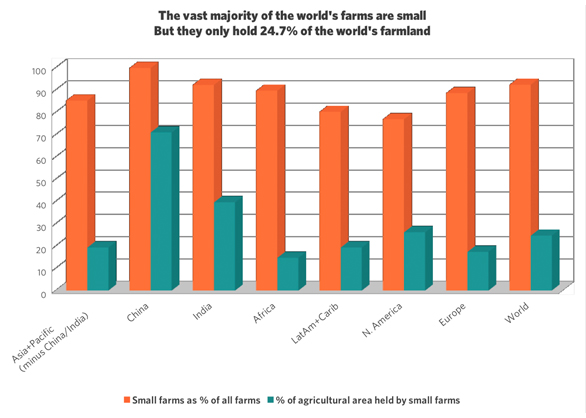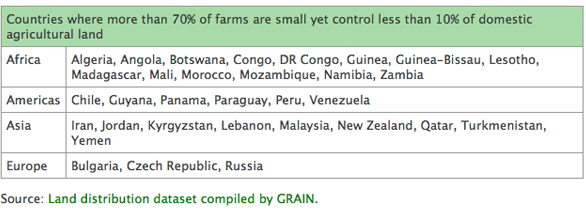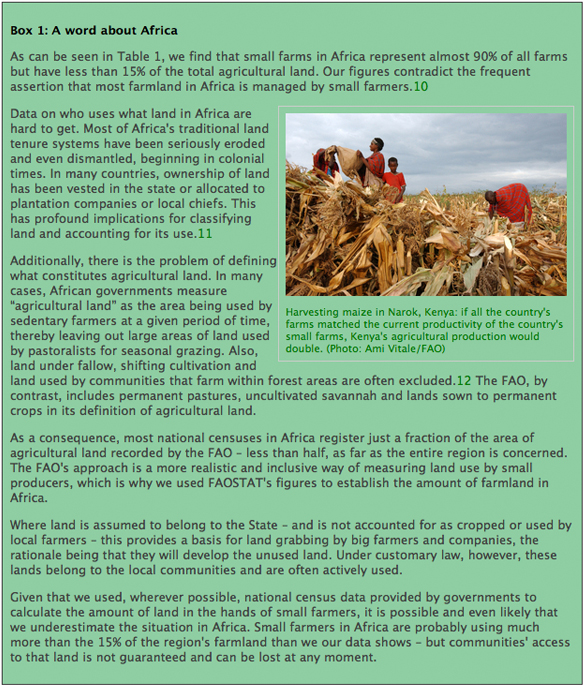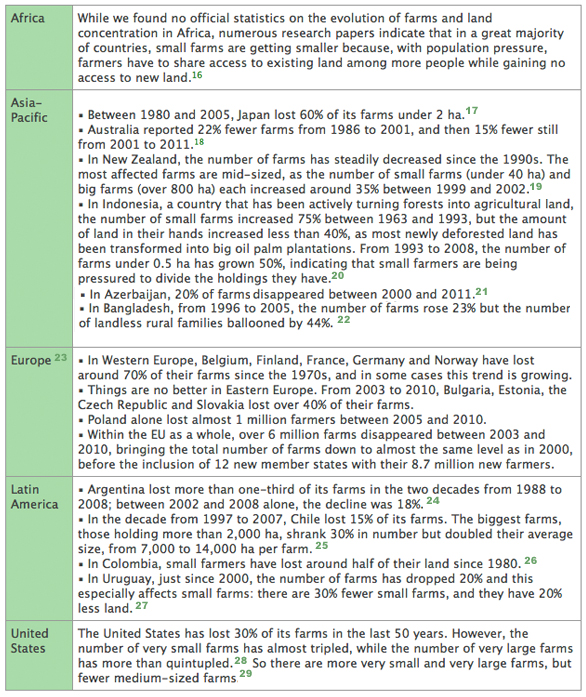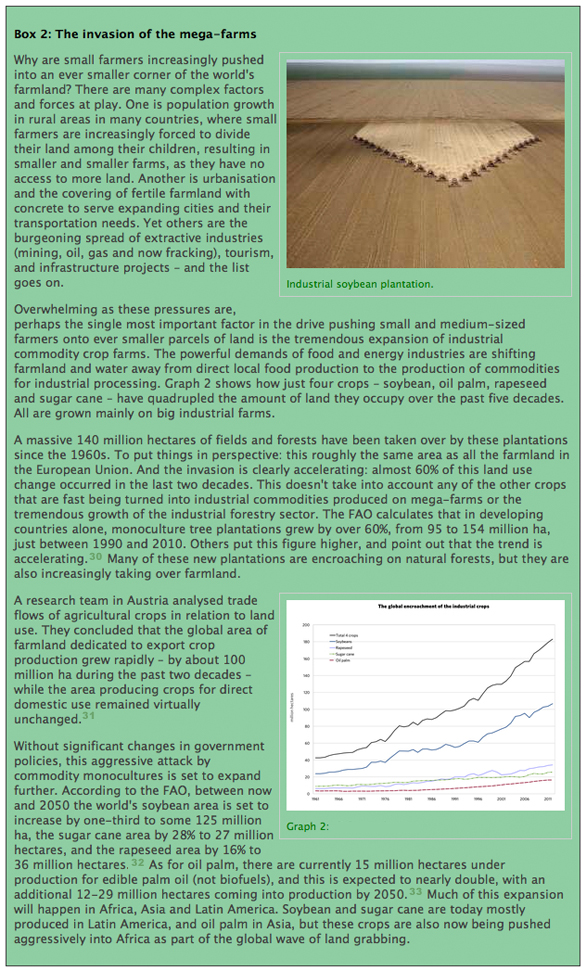|
Hungry For Land:
GRAIN is a "small international non-profit organisation that works to support small farmers and social movements in their struggles for community-controlled and biodiversity-based food systems. (Their) support takes the form of independent research and analysis, networking at local, regional and international levels, and fostering new forms of cooperation and alliance-building. Most of (their) work is oriented towards, and carried out in, Africa, Asia and Latin America." Their work goes back to the 1980s. They have published many important papers and studies. To read more about GRAIN and to access past publications, visit their site: www.grain.org .
Small Farmers Feed The World With Less Than A Quarter Of All Farmland by GRAIN Barcelona, Spain Quick Links:
But if most of the world's farmland is in small farmers' hands, then why are so many of their organisations clamouring for land redistribution and agrarian reform? Because rural peoples' access to land is under attack everywhere. From Honduras to Kenya and from Palestine to the Philippines, people are being dislodged from their farms and villages. Those who resist are being jailed or killed. Widespread agrarian strikes in Colombia, protests by community leaders in Madagascar, nationwide marches by landless folk in India, occupations in Andalusia -- the list of actions and struggles goes on and on. The bottom line is that land is becoming more and more concentrated in the hands of the rich and powerful, not that small farmers are doing well. Rural people don't simply make a living off the land, after all. Their land and territories are the backbone of their identities, their cultural landscape and their source of well-being. Yet land is being taken away from them and concentrated in fewer and fewer hands at an alarming pace. Then there is the other part of the picture: that concerning food. While it is now increasingly common to hear that small farmers produce the majority of the world's food, even if that is outside of market systems, we are also constantly being fed the message that the "more efficient" industrial food system is needed to feed the world. At the same time, we are told that 80% of the world's hungry people live in rural areas, many of them farmers or landless farmworkers. How do we make sense of all this? What is true and what is not? What action do we take to deal with these imbalances? To help answer some of these questions, GRAIN decided to take a closer look at the facts. 5 We tried to find out how much land is really in the hands of small farmers, and how much food they produce on that land. 6 The figures and what they tell us When we looked at the data, we came across quite a number of difficulties. Countries define "small farmer" differently. There are no centralised statistics on who has what land. There are no databases recording how much food comes from where. And different sources give widely varying figures for the amount of agricultural land available in each country.
Many of these conclusions might seem obvious, but two things shocked us. 1. The vast majority of farms in the world today are small and getting smaller Table 1: Global distribution of agricultural land
2. Small farms are being squeezed onto less than a quarter of global agricultural land Table 1 reveals another stark fact: globally, small farms have less than 25% of the world's farmland today. If we exclude India and China again, then the reality is that small farms control less than a fifth of the world's farmland: 17.2% to be precise. Table 2: Worst off
3. We're fast losing farms and farmers in many places, while big farms are getting bigger Almost everywhere, big farms have been accumulating more land over the last decades, with many small and medium-sized farmers going out of business. The statistics are dramatic. The official data that we were able to access are summarised in Table 3. Table 3: Losing farms, concentrating land Official data on farm losses and land concentration in Africa and Asia are harder to get, and the situation there is less clear, since contradictory factors and forces are often at play. In many countries with high levels of population growth, the number of small farms actually increases as small farms are divided up between children. But at the same time, land concentration is growing. This trend is compounded by yet another recent phenomenon: the new wave of land grabbing. The World Bank has estimated that between 2008-2010 at least 60 million hectares of fertile farmland were leased out or sold to foreign investors for the purpose of large scale agricultural projects, with more than half of this in Africa. 34 These massive new agribusiness projects are throwing an incalculable number of small farmers, herders and indigenous people off their territories. 35 Yet no one seems to have a real grasp of how much land has changed hands through these deals over the last few years. The scores, possibly hundreds, of millions of hectares of agricultural land being taken away from rural communities are not yet captured in the official statistics that were available for this report. 4. Despite their scarce and dwindling resources, small farmers continue to be the world's major food producers At a time when agriculture is almost exclusively judged in terms of its capacity to produce commodities, one tends to forget that the main role of farming is feeding people. This bias has infiltrated national census data, too, as many nations do not include questions about who produces what and with what means. However, when that information is available, a clear picture emerges: small farmers still produce most of the food. They are feeding the world. The UN Environment Programme, the International Fund for Agricultural Development, FAO and the UN Special Rapporteur on the Right to Food all estimate that small farmers produce up to 80% of the food in the non-industrialised countries. 37
If small farmers have so little land, how can they provide most of the food in so many countries? One reason is that small farms tend to be more productive than big ones, as we explain in the next section. But another factor is this historical constant: small or peasant farms prioritise food production. They tend to focus on local and national markets and their own families. Much of what they produce doesn't enter into national trade statistics, but it does reach those who need it most: the rural and urban poor.
In the European Union, 20 countries register a higher rate of production per hectare on small farms than on large farms. In nine EU countries, productivity of small farms is at least twice that of big farms. 55 In the seven countries where large farms have higher productivity, it is only slightly higher than that of small farms. 56 This tendency is confirmed by numerous studies in other countries and regions, all of them showing higher productivity on small farms. 6. Most small farmers are women, but their contributions are ignored and marginalised The role of women in feeding the world is not adequately captured by official data and statistical tools. FAO, for example, define only as people who get a monetary income from farming as ìeconomically active in agricultureî. Using this concept, FAOSTAT indicates that 28% of the rural population in Central America are ìeconomically activeî and that women form just 12% of that group! 60 According to FAO, fewer than 2% of landholders worldwide are women, but figures vary widely. 70 There is broad consensus, however, that even where land is registered as family or joint property between men and women, men still enjoy much wider powers over it than do women. For example, a common situation is that men can make decisions about the land on behalf of themselves and their spouses, but women cannot. Another impediment is that in giving credit, governments and banks require women to present some form of authorisation from their husbands or fathers, while men encounter no such barrier. It is no surprise, then, that available data show that only 10% of agricultural loans go to women. 71 Additionally, inheritance laws and customs often work against women. Males tend to have priority or outright exclusivity in the inheritance of land. In many countries, women can never gain legal control over land, with authority passing to their sons if they are widowed for example. The data above support the contention that women are the main food producers on the planet, although their contribution remains ignored, marginalised, and discriminated against. Reversing the trend: give small farmers the means to feed the world As the data show, land concentration in agriculture is reaching extreme levels. Today, the vast majority of farming families have less than two hectares to feed themselves and humankind. And the amount of land they have access to is shrinking. How are small farmers supposed to sustain themselves in these conditions? Most families that depend on a small farm need to have family members working outside the farm in order to be able to stay on the land. This situation is often described euphemistically as "diversification", but in reality it means accepting low wages, and bad working conditions. For the rural families of many countries, it means mass migration leading to permanent insecurity both for those who leave and for those who stay. Also, living and working on a small farm often consists of long and difficult working hours, no holidays, no pensions, no retirement for the elderly and irregular school attendance for children.
The situation facing women farmers also requires urgent action. Many international agencies and governments are currently discussing these issues. Land access for women is specifically part of the Millennium Development Goals. The FAO has written numerous documents advocating for women's rights over land and agricultural resources. The issue is being considered by the UN Development Programme, the World Bank, the Gates Foundation, the G8 and the G20, among others. However, what these institutions are advocating is often not what women farmers and women's organisations have been struggling for. Such institutions often advocate a system of land rights based on individual property titles that can be bought and sold or used as collateral. This is likely to lead to further concentration of land, just as the allocation of individual land property rights to men has done historically around the world. 72 Doing nothing to turn this situation around will be disastrous for all of us. Small farmers – the vast majority of farmers, who tend to be the most productive and who produce most of the world's food – are losing the very basis of their livelihoods and existence: their land. If we do nothing, the world will lose its capacity to feed itself. The message, then, is clear. We urgently need to launch, on a scale never seen before, genuine agrarian reform programmes that get land back in the hands of small and peasant farmers.
What sources of data were used? Gathering and analysing data on land distribution and food production raises major questions and problems. First, data on farms, farmers, rural people and food are often patchy, slanted, or influenced by the politics of those who collect them. Second, classification criteria and definitions are highly variable. Although government statistics are no exception to such problems, we have used government sources, most often provided by national agricultural censuses, as much as possible because they provide the most comprehensive data. We also used data provided by FAOSTAT and other FAO sources, and we incorporated data from research papers when other data was not available at national level. This means that we have used data from various years, in some cases from 10 or more years ago. If this had any impact on our results, it is most likely that the amount of land in the hands of small farmers has been overestimated, since with few exceptions the worldwide trend is towards less land in the hands of small farmers. The sources for each case are indicated in the dataset accompanying this report. 73 Outside Europe and the Americas, data for around one-quarter of the world's countries – representing around 12% of all agricultural land and about the same fraction of global rural population – was either partial or not available. We estimated the number of farms and small farms and the amount of land in the hands of small farmers in these countries based on total agricultural land (provided by FAOSTAT), rural population (provided by UN Department of Economic and Social Affairs) and average household size per country (provided by UN Habitat). What definition of small farms was used?
What is a small farm? The area of land it occupies is not the only significant parameter. Twenty hectares may be very big in India but very small in Argentina. Access to irrigation, the fertility of the soil, the type of production being undertaken, climate and topography are all factors in determining what is considered a small farm and what is not. There is clearly no universal definition of a small farm, and GRAIN had no possibility of adopting one. Building or proposing an all-encompassing definition was impossible because in many cases it would have rendered the available data inapplicable or impossible to interpret. We also avoided the concept of "family farm" that FAO and others are now promoting in the context of the International Year of Family Farming. Although it can be a meaningful concept in many countries, the definitions used are so broad and ambiguous that they can hide serious contradictions, sometimes with unintended consequences. In addition, few official statistics provide data on family farming. Hence, we decided to use the definition of “small farms” provided by the national authorities of each country. When such criteria were not available, we adopted the definition of the World Bank (farming households with less than 2 hectares). An exception was made in the case of the US, where according to official criteria any farm with an annual turnover of less than US$250,000 is considered small. Given that this would seriously contradict other criteria on what a small farm is (such as the destination of production or the source of labour), we opted for the criterion put forward by Lincoln University in Nebraska, which defines a small farm in the US as one with a turnover of US$50,000 or less per year. We have, therefore, used several definitions of small farms in this report. These definitions are based on data and measurements as disparate as gross income, gross sales, amount of land, source of farm labour and type of resources – or combinations of these. Still, we believe that this approach gives the best approximation of reality, since the criteria used by each country do represent certain aspects of small farms. What kind of land are we talking about? Farmers, and more so small farmers, carry out a wide range of agricultural activities under quite diverse arrangements. These include intensive management of horticultural crops, crop rotations with annual forages, agroforestry, shifting cultivation, livestock rearing, fish farming and pastoralism, or any combination of these. Governments and FAO classify land under different categories according to how the land is used, and they collect data accordingly. The EU accounts for all the land within a farm, no matter how it is being cropped or utilised. The same holds for the US, Brazil, Argentina and India. But in Africa, many governments exclude communal land and grazing areas from the statistics, thus greatly underestimating the land area used by farmers. Once again, different criteria are being employed, and we had no means of selecting or disaggregating data (for example, cropped land versus total agricultural land) governments or other agencies had collected under a single heading. The FAO provides figures on total agricultural land for almost every country in the world, even for those where no census data are available, and defines total agricultural land as the sum of the following areas: arable land - land under temporary agricultural crops, temporary meadows for mowing or pasture, land under market and kitchen gardens and land temporarily (for less than five years) fallow. Missing: the landless, the urban food producers, extractive industries and land grabbing Our research left out numerous realities, either because they were outside the scope of this study or because we did not find enough data. One important missing element is the situation of landless food producers and workers. Landlessness is a major and increasing reality in many countries, as the Movimento dos Trabalhadores Sem Terra (MST), the largest social movement in Brazil, so clearly testifies. Nor did we examine urban food producers, an increasingly important factor in global food production. Very few countries provide data on them, and we could not compile significant figures on their situation worldwide. Through our work and that of our partners, GRAIN is keenly aware that urbanisation, the extractive industries, hydroelectric dams and many other industrial mega projects are increasingly advancing over farmland, forest lands, water sources, farming communities and indigenous peoples' territories. They are massively affecting the availability of agricultural land in the world, but since much of their rapid expansion is relatively recent, they are often not adequately addressed in agricultural land statistics. And finally, also missing in our calculations is the recent wave of land grabbing that is now handing millions of hectares of fertile farmland to large corporations and depriving tens of thousands of farming communities of their livelihoods. Today's massive land grab took off only in the last decade and has yet to be captured in the official statistics. Published in In Motion Magazine July 15, 2014 |
||||||||||||||
If you have any thoughts on this or would like to contribute to an ongoing discussion in the  What is New? || Affirmative Action || Art Changes || Autonomy: Chiapas - California || Community Images || Education Rights || E-mail, Opinions and Discussion || En español || Essays from Ireland || Global Eyes || Healthcare || Human Rights/Civil Rights || Piri Thomas || Photo of the Week || QA: Interviews || Region || Rural America || Search || Donate || To be notified of new articles || Survey || In Motion Magazine's Store || In Motion Magazine Staff || In Unity Book of Photos || Links Around The World || OneWorld / US || NPC Productions Copyright © 1995-2014 NPC Productions as a compilation. All Rights Reserved. |


